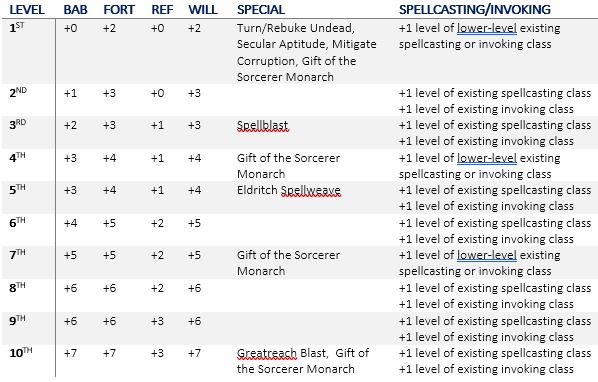Now that we have a good templar, I am working on a warlock templar for people that like that approach. Maybe templars are warlocks, like in 4E. Maybe warlock templars and cleric style templars work alongside. Perhaps only some Sorcerer Monarchs have warlock templars, as I suggested with a salient feat from my Epic Athas work. It is your choice how you want to handle it. In the spirit of choice, here are some warlock invocations for the Dark Sun setting.
New Invocations
Whispers of the Sorcerer King
Least; 2nd
You hear whispers in your ears, revealing secrets of Athas. Select three knowledge skills. You gain a +6 bonus on those three Knowledge skill checks for 24 hours. Once the 24 hours has elapsed, a different three knowledge skills may be selected.
Sorcerer King’s Protective Screen
Least; 2nd
You bring forth the protection of your sorcerer monarch, protecting yourself from arrows as if under a protection from arrows spell. Sorcerer King’s Protective Screen lasts for 24 hours or until discharged.
Sorcerer King’s Elite Guard
Least; 2nd
You call on your sorcerer monarch to imbue you with size and strength, intimidating the enemies of your leader. You get the benefits of an enlarge person spell and bless spell (bless giving you a +1 morale bonus on attack rolls and on saving throws against fear effects). Sorcerer King’s Elite Guard lasts for 1 minute per caster level or until discharged.
Cool Oasis
Least; 2nd
You bring forth your sorcerer monarch’s succor. You get the benefits of the cooling canopy spell (Dark Sun Core Rules 3.5, page 148) and the sustenance psionic power. Cool Oasis lasts for 24 hours or until discharged.
Utterance of War
Dark; 7th
You bring valor and fury to your allies. You invoke the effects of a crusade spell (Dark Sun Core Rules 3.5, page 149). Invoking this invocation while it is still active discharges the previous invocation.
Find the Enemy
Least; 2nd
You seek out the enemy of your leader. You can invoke the effects of the footsteps of the quarry spell (Dark Sun Core Rules 3.5, page 156). In addition, you gain a +2 bonus to Intimidate and Sense Motive checks against the named enemy.
Avatar of the Sorcerer King
Dark; 6th
You become an avatar of your sorcerer monarch. You can invoke the effects of the transformation spell. Additionally, you get damage reduction 10/magic. If you have spellcasting ability, that ability is lost as detailed in the transformation spell description, nor may you use spell trigger or spell completion magic items, but your invocations are unhindered.
Aura Audit
Least; 1st
You know things about the citizens and slaves of your city. You can invoke the effects of the aura reading psionic power (Dark Sun Core Rules 3.5, page 178).
Sorcerer King’s Strength
Lesser; 3rd
When you use this invocation, your strength increases exponentially. You can carry heavy loads effortlessly, and your strength increases for other purposes also. You get the benefits of the psionic lighten load power (Dark Sun Core Rules 3.5, page 184), enabling you to increase your carrying capacity as if your Strength score was increased by 10 points, and an effect similar to the bull’s strength spell, except that instead of an enhancement bonus, you are granted a +4 morale bonus to Strength. Sorcerer King’s Strength lasts for 2 hours per caster level or until discharged.
Thousand Eyes of the Sorcerer King
Lesser; 3rd
Your sorcerer monarch grants you the power to truly see. You get the benefits of the ubiquitous vision psionic power, allowing you to see in a 360-degree sphere. Thousand Eyes of the Sorcerer King lasts for 24 hours or until discharged.
Sorcerer King’s Arsenal
Least; 1st
You call echoes of weaponry used by the soldiery of your sorcerer monarch into your hands. You can invoke the effects of the call weaponry psionic power. For every 4 caster levels you have, this invocation is augmented by 4 additional power points.
Mind Shield of the Sorcerer King
Least; 2nd
As a valuable agent of your sorcerer monarch, you gain protection against psionic and magical mind affecting intrusions. As an immediate action, you can invoke the effects of the thought shield psionic power. This invocation protects against both magical and psionic mind-affecting effects. For every 4 caster levels you have, this invocation is augmented by 1 additional power point, gaining the benefits detailed in the description of the power.
Sorcerer Monarch’s Injunction
Greater; 5th
Your sorcerer monarch grants you the power shatter mind blank effects and break enchantments. When you use this invocation, you may choose to invoke the effects of the shatter mind blank psionic power or the break enchantment spell. Your manifester/caster level equals your caster level for this invocation.
Punish the Cowards
Lesser; 3rd
You do not allow your servants to betray you or your monarch out of cowardice or weakness. You can invoke the effects of the infallible servant spell (Exemplars of Evil, page 27). This invocation differs from the spell description as any capture causes the spell to take effect, regardless of the captors alignment. You may have a number of servants affected by this invocation up to your Charisma ability modifier.
Sorcerer Monarch’s Sight
Greater; 5th
Your ability to perceive is almost as good as that of your sorcerer monarch. You get the benefits of the dragonsight spell (spell compendium page 73), enhancing your visual acuity. Sorcerer King’s Sight lasts for 24 hours or until discharged.
Cosmic Cognition
Dark; 9th
Nothing can be hidden from you. You can invoke the effects of the cosmic awareness power (Dark Sun Core Rules 3.5, page 180).

